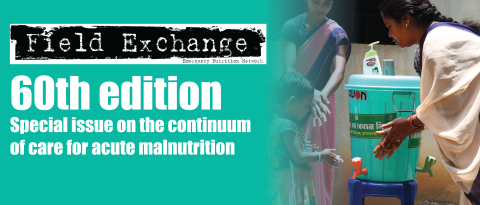Protocol adaptations to deal with programme realities: UNICEF Nigeria perspective
This is a poscript for the field article 'Simplified approaches to treat acute malnutrition: Insights and reflections from MSF and lessons from experiences in NE Nigeria' by Kerstin Hanson, which you can read here.
By Sanjay Kumar Das, Reuel Kirathi Mungai and Maureen Gallagher
Sanjay Kumar Das is a nutrition manager at UNICEF Maiduguri office for the North East Nigeria response.
Ruel Kirthai Mungai is Nutrition Specialist (Emergency Response Team) at UNICEF New York and former Nutrition Sector coordinator in Nigeria, based in Borno.
Maureen Gallagher is Chief of Nutrition for UNICEF Afghanistan. She was previously the Nutrition Specialist with UNICEF’s Emergency Response Team based in UNICEF headquarters, when she supported emergencies, including the Nigeria response.
Prior to 2016 international humanitarian organisations supporting Borno state primary healthcare in the management of acute malnutrition was limited to a handful of partners. Due to the security situation and limited access, all humanitarian coordination was initially undertaken from Abuja, with consultations with state leadership and humanitarian coordination organisations. By the end of 2016 coordination was decentralised to Borno.
Robust nutrition-situation analysis was undertaken collaboratively by humanitarian partners and the state with technical support from UNICEF as cluster lead agency. This led to the declaration of a nutrition emergency on June 2016 by the then Federal Minister of Health. This declaration led to an upsurge of humanitarian partners working in the nutrition sector, as well as the formal activation of the sector to respond to the Level 3 humanitarian crisis. The crisis in North East Nigeria, with its epicentre affecting Borno state, was reflected in high malnutrition prevalence. At the height of the crisis in 2017 there were an estimated 520,393 malnourished children in the state, the majority of whom were in the host community and in access-challenged local government areas.
The Nigerian community-based management of acute malnutrition (CMAM) guideline recognises the use of both mid-upper arm circumference (MUAC) and weight-for-height z-score (WHZ) as admission criteria. With the high burden of acute malnutrition and a fragile health system operating below 40% capacity, the sector agreed with all partners on the use of MUAC only as the admission and discharge criteria for treatment. The Nigerian CMAM guideline also recognises the absence of services for the management of moderate acute malnutrition (MAM); therefore, MUAC above 12.5 cm is used as a discharge criterion for those treated for severe acute malnutrition (SAM).
Following the establishment of the nutrition surveillance system, the nutrition sector identified pockets of extremely high global acute malnutrition (GAM) rates, with access challenges where a standard CMAM service-delivery approach through the health system was not feasible. Through the CMAM Technical Working Group (TWG), some partners requested the use of the expanded admission criteria (EAC) in such locations. This was discussed and the use of the EAC was approved for use in specific circumstances. Key concerns from the state and federal nutrition focal persons were availability of ready-to-use therapeutic food (RUTF) supplies (as the numbers of malnourished children were high); challenges resulting from the misuse of RUTF if the EAC was not properly undertaken; criteria for activation and deactivation; and reporting tools to be utilised. These concerns were discussed by the CMAM TWG and operational guidance was adopted from the global tool ‘Options for exceptional community-based management of acute malnutrition programing in emergencies’ to set criteria and boundaries for temporary adaptations in this exceptional situation.
For more information, please contact Sanjay Kumar Das.


